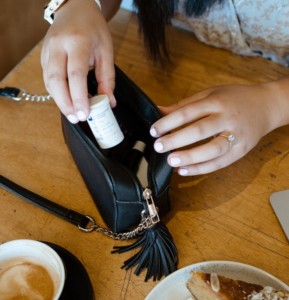Type 1 diabetes supplies: what should I pack in my bag and store at home?
This is an excerpt from Straight to the Point, our must-have guide for adults living with type 1 diabetes. Download your FREE copy.
Whether you’ve been living with type 1 diabetes for a little while or a long time, you already know that your type 1 diabetes supplies are your lifeline. But when is the last time you replenished these supplies? Have you recently taken stock of what’s in your bag and at home to ensure you’re not left in the lurch at a critical time?
As we head into the festive season and the new year it’s a good time to conduct a stock take on your type 1 diabetes supplies so you’ll be organised and ready for managing type 1 diabetes no matter what life throws at you.
Here’s a list of must-have type 1 diabetes (T1D) supplies for your bag and in your home.

Your type 1 diabetes supplies: in your bag
Your essential T1D supplies should be with you as you go about day-to-day life. It’s good to use a bag that has multiple pockets – enough that you can easily find what you’re searching for and will protect the contents from any damage.
You could browse suppliers like Diabete-Ezy, Diabetes HQ, Glucology by IBD Medical or RockaDex for your diabetes bag, or search for your own favourite.
1. Your insulin (plus your pen/syringe/pump)
You should always carry insulin with you plus the means to deliver it, even when you don’t expect to eat. You never know when you might be out longer than you expect!
2. Blood glucose meter, strips and lancing device, or fully charged mobile device
Knowing what your blood glucose levels (BGLs) are doing will help you avoid hypoglycaemia (a ‘hypo’). Type 1 diabetes monitoring will also help reduce your risk of high blood glucose levels, which can leave you feeling tired and emotional.
If you use a CGM or flash GM, it’s still a good idea to carry a meter with you as a back-up for managing type 1 diabetes.
3. Finger wipes (optional but handy)
The accuracy of your BGLs can be impacted by the presence of food on your fingers, so these are incredibly useful to ensure you have clean fingers when checking them.
4. Hypo treatment
Always carry at least one ‘hypo fix’ with you. Six to eight large jelly babies or jellybeans should do the trick to help you in case of a hypo.
5. A logbook or BGL tracking app
Recording your BGL readings (if you don’t have access to a CGM) can make it easier for both you and your healthcare professional to identify patterns and make long-term improvements in the way you manage your T1D.
Some great recommendations from our community include mylife, mySugr and Glucose Buddy.
6. Your T1D identifier
It’s a clever idea to have a T1D identifier on your person or in your wallet. This identifier should:
- make it clear you live with T1D
- provide your doctor’s contact details
- include a brief description of the medication you’re taking, and the dosage.
Your type 1 diabetes supplies: at home
There are a few type 1 diabetes supplies you might not need as often as those you take with you in your everyday kit. But that doesn’t mean you don’t need to have them handy for situations when you do need them! How many do you have at home from this list?
1. Sharps container
A medical sharps container is essential for the safe storage and disposal of used pen needles, syringes and lancets. You can find them in pharmacies or using online diabetes suppliers.
In some states, a sturdy plastic bottle with a screw-on lid will be accepted for disposal.
2. Ketone strips
Have some way to check for ketones, either using urine strips or blood strips. This kind of type 1 diabetes monitoring will help you identify if you need urgent help.
3. GlucaGen HypoKit
The GlucaGen HypoKit is available on prescription and contains an injection which is used to rapidly raise blood glucose levels when someone has lost consciousness due to a severe hypo or is unable to take glucose orally.
Managing type 1 diabetes in day-to-day life
Having all these items on hand might sound a little daunting to those new to the T1D community, but we’re here to support you. You can also join our private Facebook groups (for people aged 14 to 24, or 25 years and over) to ask others living with T1D for their T1D management advice.
In the meantime, here are some quick tips that have worked for members of our community:
- Use a diary or calendar (either old-school pen and paper or as a reminder in your phone) to schedule times to check on your T1D supply stashes. Some items might need checking every few weeks, while others can be checked every couple of months.
- Set up a shopping schedule, or look into services like Stripped Supply, which can help you stay on top of your consumables.
- If you’re buying products in advance or in bulk, remember to check their use-by dates regularly, throwing our anything that has passed its expiry date.
- Pencil in when your appointments with your healthcare team are due well ahead of time – see our checklist of when to have specific T1D checks and tests with your specialists.
For more information on T1D supplies and consumables, download Straight to the Point, the guide for adults living with type 1 diabetes.

Want more tips on getting organised?
Fill out this form to have Straight to the Point: A guide for adults living with T1D sent directly to your inbox.



